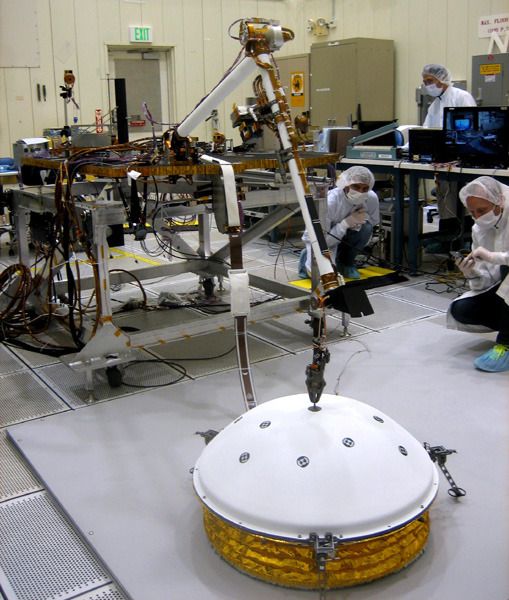
NASA / JPL - Caltech
Single Site on Mars Advanced for 2016 NASA Lander (Press Release)
NASA's next mission to Mars, scheduled to launch one year from today to examine the Red Planet's deep interior and investigate how rocky planets like Earth evolved, now has one specific site under evaluation as the best place to land and deploy its science instruments.
The mission called InSight -- an acronym for "Interior Exploration using Seismic Investigations, Geodesy and Heat Transport" -- is scheduled to launch from Vandenberg Air Force Base, California. The launch period runs from March 4 to March 30, 2016, and will mark the first California launch of an interplanetary mission. Installation of science-instrument hardware onto the spacecraft has begun and a key review has given thumbs up to integration and testing of the mission's component systems from several nations participating in the international project.
The landing-site selection process evaluated four candidate locations selected in 2014. The quartet is within the flat-lying "Elysium Planitia," less than five degrees north of the equator, and all four appear safe for InSight's landing. The single site will continue to be analyzed in coming months for final selection later this year. If unexpected problems with this site are found, one of the others would be imaged and could be selected. The favored site is centered at about four degrees north latitude and 136 degrees east longitude.
"This is wondrous terrain, exactly what we want to land on because it is smooth, flat, with very few rocks in the highest-resolution images," said InSight's site-selection leader, Matt Golombek of NASA's Jet Propulsion Laboratory, Pasadena, California.
Mars orbiters have provided detailed information about the candidate sites, which are mapped as landing ellipses about 81 miles (130 kilometers) west-to-east by about 17 miles (27 kilometers) north-to-south. An ellipse covers the area within which InSight has odds of about 99 percent of landing, if targeted for the ellipse center. Several types of terrain, such as "cratered," "etched" and "smooth" were mapped in each ellipse. The one chosen for final evaluations has highest proportion in the smooth category.
After InSight reaches Mars on Sept. 28, 2016, the mission will assess properties of the planet's crust, mantle and core. The interior of Mars has not been churned as much as Earth's because Mars lacks the tectonic activity that recycles Earth's crustal plates back into the mantle. Thus, Mars offers an opportunity to find clues no longer present on Earth about how rocky planets such as Earth, Mars, Venus and Mercury formed and evolved.
InSight's primary science will study the planet's interior, not surface features. Besides safety for the landing, the main site-selection criterion is for the ground within reach of the lander's robotic arm to be penetrable for a heat-flow probe designed to hammer itself into the soil to a depth three to five yards, or meters.
Evidence that the ground will be suitable for the probe, rather than rock solid, comes from assessment by the Thermal Imaging System on NASA's Mars Odyssey orbiter of how quickly the ground cools at night or warms in sunlight, and evaluation of images from the High Resolution Imaging Science Experiment on NASA's Mars Reconnaissance Orbiter.
The heat-flow probe is a key part of InSight's Heat Flow and Physical Properties Package (HP3) provided by the German Aerospace Center (DLR). Electronics for that instrument were the first hardware from the science payload put onto the InSight spacecraft being assembled and tested at Lockheed Martin Space Systems, Denver.
"As flight components such as the HP3 electronics become available, our team continues to integrate them on the spacecraft and test their functionality," said Stu Spath, InSight spacecraft program manager at Lockheed Martin. "We're steadily marching toward the start of spacecraft environmental testing this spring."
InSight's robotic arm will also place another science instrument onto the ground. This is the Seismic Experiment for Interior Structure, or SEIS, from the French Space Agency (CNES), with components from Germany, Switzerland, the United Kingdom and the United States.
A third experiment will use the radio link between InSight and NASA's Deep Space Network antennas on Earth to measure precisely a wobble in Mars' rotation that could reveal whether the planet has a molten or solid core. Wind and temperature sensors from Spain's Center for Astrobiology and a pressure sensor will monitor weather, and a magnetometer will measure magnetic disturbances.
The project passed its System Integration Review in February. "A panel of experts from outside the project reviewed the system-level integration and test program," said InSight Project Manager Tom Hoffman, of JPL. "For Insight, there are multiple systems being brought together from several countries for final integration and testing in Denver."
InSight and other NASA current and future projects will help inform the journey to Mars, an agency priority to send humans to the Red Planet in the 2030s.
JPL manages InSight for NASA's Science Mission Directorate in Washington. InSight is part of NASA's Discovery Program, managed by NASA's Marshall Space Flight Center in Huntsville, Alabama.
Source: Jet Propulsion Laboratory
****

NASA / JPL - Caltech

No comments:
Post a Comment